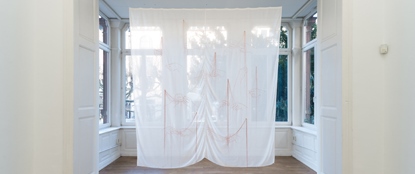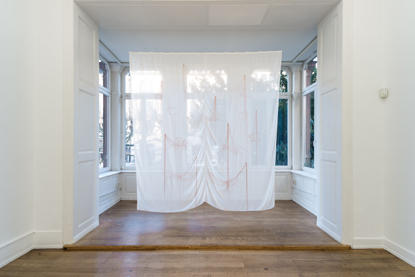The term installation derives from the Latin installare. Something is "put in place," local and often expansive. The kick off of the exhibition year 2014 is dedicated by the Nassauischer Kunstverein Wiesbaden to the artistic medium installation with an international group show. The etymology of the term which describes situational space arrangements since the 1970s for the Visual Arts, serves the concept as an inspiration: the exhibition rooms in a villa dating back to the 19th century, with two almost identical "residential floors" with different "rooms." Each participating artist is invited to "furnish" one of these rooms. The focus is not on a thematic title and thus a curatorial superstructure, but rather targeted to enable the perception of the existing from different perspectives opening multiple insights, entrances and passages and new viewing angles. The title INSTALLATION VIEW reflects this undertaking without distracting from the essence, the spatial art.
At the beginning of the tour, SIMON SPEISER asks the visitors to take a seat. From a gaming chair, a special chair which intensifies the immersion into the digital world, SPEISER designed an interactive work with a specially composed soundtrack scrutinizing, whether fiction has merged and already become part of the consumable reality. The room-filling, silent and sacral seeming installation by SANDRA MEISEL abstracts the motive of church interiors, which partially conceals views of the neighbouring neo-Gothic brick Church. While combining indoor and outdoor space and she transfers a very personal event in her life into her artistic work. The size of the installation is inspired by the dimension of the work space, which she structures and accentuates, an artistic approach, which is also a feature in JONG OH translucent installations who it seems understands space as a medium for pictures His minimalist installations resemble elegant abstract drawings, which with a seemingly effortless stroke are placed weightless in space.
The film "How to Sweep" by TOM SACHS demonstrates in an ironic way how to acquire a room with an everyday action. In the tradition of Fluxus instructions, the artist raises cleaning from the trivial level to become a highly specialized and efficient operation with meditative potential. Also AIKO TEZUKA deconstructs the "Everyday," however, in her installations and objects, alternating between tenderness and severity, she uses textiles as material, a tactile material. In a complicated and time-intensive process she reveals hidden levels and stories in the material, creating new views on structures and metamorphoses. The object "Bag Bang" by SANDRA KRANICH will undergo a temporal process during the opening of the exhibition. Following her art training, she also trained as a pyrotechnist; so it may be justified to assume that the title "Bag bang" is not only an onomatopoeic title.
Like after the "big bang" the expansive installation "Memory of a File (Let Go or Be Dragged)" by NICK MAUSS spreads out in the room, a conglomerate of silver mesh, slats and by repeated copying, faded photographs of the Catalan artist Josep Maria Sert (1876-1945). The title suggests the ambivalence in the desire, to make things tangible, which only present themselves as faded in memory and at the same time to discard them. Color is the starting point in the installations of ALONA RODEH and YONATAN VINITSKY. Like a Ribbon shiny metallic stripes in black, red and yellow stretch over a brightly lit room. RODEH’s idea to transfer the minimalist aesthetics of a gas station to an exhibition space was realised for the first time in the year 2000. Her research revealed that the perfect colour sequence for gas stations is one of the German Federal flag - and impossible, almost forbidden in her homeland of Israel. VINITSKY draws on the work of different artists as material for his own, conceptual work. At the Kunstverein, he reconstructs an installation of the artist Blinky Palermo who died young at the age of 33 years - VINITSKYS own age in 2014 - including its development. The installation, as an intermediate step in the development of his own work, exists only as a photographic document.
Overlooking the essential - the diverse subjective interpretations of space by the artists - in relation to one’s own "installation" within the exhibition in the role of the spectator, the dualism between active and passive: to what extent can I set myself intellectually into the art work, and does it allow me to do so?



